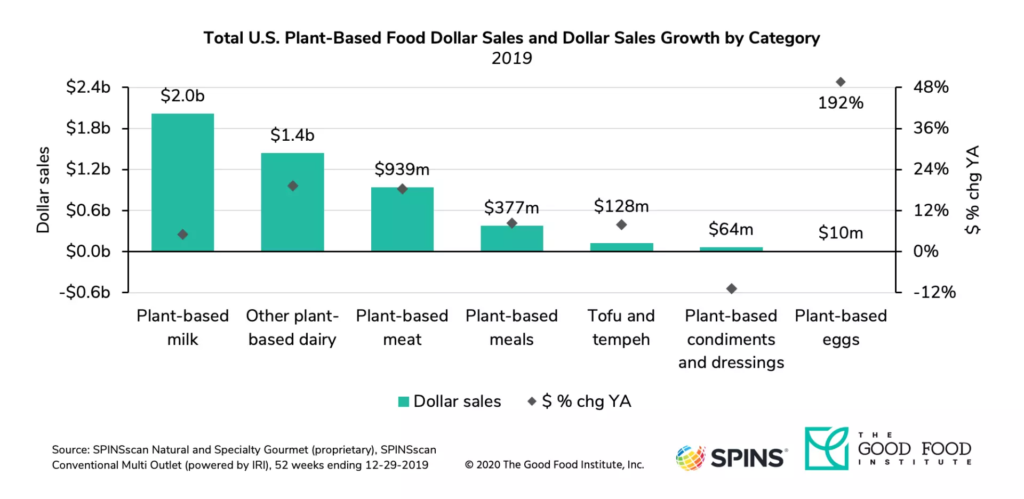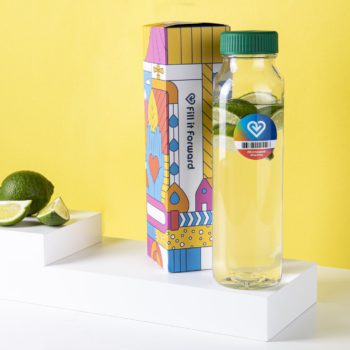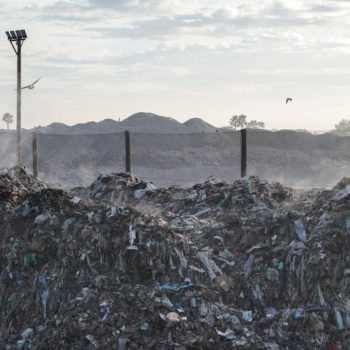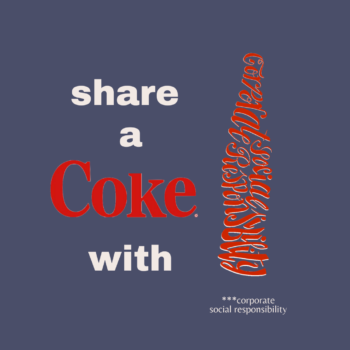|
|
Oat, almond, soy, cashew, hazelnut, rice, pea, flax. There must be a dozen others. We’ve heard about the heavy water use needed for almonds. Or maybe the heavy fertilizers needed for soy. Let’s break a few myths and delve into the sustainability of plant milk.
Busy? Try the speed read.
The scoop: All plant milk is more sustainable than dairy milk. But that doesn’t mean all plant milks are sustainable.
SR’s favorites:
- Pea milk: protein-rich, noninvasive crop, good taste.
- Hemp/flax seed milk: nutritious and low emission-based.
- Hazelnut milk: tastes great in a cup of coffee, pollinates naturally, grows on trees.
Bottom line: Every company has a different process, but we can draw conclusions about the sustainability of certain crops. As consumer interest in plant milk keeps growing, it’s important to distinguish good labels from bad labels.
The best best thing you can do is make your own plant milk at home. Just take your favorite organic, fair-trade nut or seed and mix it with water in a blender. Details below!
Dig deeper → 6 min
Plant milk ↑ animal milk ↓
We’re here for the sustainability of different milks, not the market stats. So, I’ll keep the trends simple. The plant milk market is trending up, and the dairy/animal milk industry is trending down.

Or, another way to put it, dairy farms (even the big ones) are closing around the country, while major plant brands like Oatly celebrate IPOs. The Swedish oat milk brand was valued at around $10 billion!
Here’s a good resource from the Good Food Institute on the alternative milk industry trends for number nerds like me.
Dairy as a comparison
We must compare the sustainability of plant milk to traditional animal milk, so here are some sustainability stats for dairy.
According to World Wildlife Foundation, a glass of milk requires about 144 gallons in the US. More than 93% of that water is used to grow feed for dairy cattle. 100 pounds of feed is eaten per day by a US dairy cow. And 9% Amount of available US cropland used to grow feed crops for dairy cows—about 34.1 million acres.
Without further ado, let’s break down the sustainability of each plant milk.
All milks are not equal
It’s important to note that every brand is different. In order to evaluate a product’s sustainability, you have to break down it’s Life-Cycle Assessment. A Life-Cycle assessment is a research benchmark that assesses the potential environmental impact of a product or service.
So, it can be complicated to define the sustainability of a plant milk like almond if they have hundreds of different processes. Plus, incorporating other factors like nutrition impacts sustainability too.
Example of nutrition’s role in sustainability:
Take one cup of dairy milk that requires heavy land use and water use. It is much richer in nutrients compared to a cup of almond milk. If you want to achieve equal land and water use for almond milk, you will receive larger quantities of almond milk. So, it’s better for the environment, right?
Well, if that extra almond milk matches a lower quantity of dairy milk to achieve equal nutritional value, than almond milk may not necessarily be more sustainable.
Water and almond milk
Pros: Less land usage, low GHG emissions. Cons: Heavy water use, severe impact on bees.
Almonds do not require a lot of land nor energy to create milk. That’s not the issue. The problem is one glass of almond milk requires about 130 pints of water. And most almonds grown for milk are harvested in California, where heavy water use is kind of a big deal.
Meanwhile, almost 70% of commercial bees are involved in the almond industry. Pretty crazy, right? A ton of bees die every year from the heavy work load requires to pollinate the almond trees.
The sustainability of oat milk
Pros: Environmentally strong choice. Cons: Health standards? Non-organic oats may contain traces of glyphosate.
Oats are a low-input “hero” crop. They reduce soil erosion and encourage crop diversity. Oat milk is the fast growing commodity in the alternative dairy space, surpassing almond milk in 2019.
As mentioned, Oatly filed for a massive IPO and oat milk is here to stay. Nothing to complain about from an environmental standpoint. However, conventionally grown oats have been linked to glyphosate, the famous Monsanto Roundup ingredient that farmers sued for causing cancer. The current parent Bayer denies that allegation.
A study conducted by the Environmental Working Group found that all of the foods containing conventionally grown oats had glyphosate, and one third of organic oats contained the controversial ingredient. Swedish oat giant Oatly claims their milk is completely glyphosate-free.
The sustainability of coconut milk
Pros: Tasty, easy to grow. Cons: History of unfair trade practices, animal abuse. Look for fair-trade certified, organic coconuts.
Coconuts are extremely popular across the world. And they make an easy, tasty dairy alternative. The key here is to buy fair-trade certified coconut products.
The coconut trade has similar origins as palm oil and other tropical supply chains. An investigation by the New York Times found that rainforests in Indonesia were cut at the rate of three acres per minute over the course of seven years to make room for coconut palm trees.
As the world rejected palm oil due to heavy media coverage, global interest in coconut products spiked. Then, producers had to meet this unprecedented demand. This resulted in some serious human and animal rights violations. Coconut milk isn’t inherently unethical or bad for the environment, just look for fair trade and organic labels.
Sustainability of Hemp / Flax Milk
Pros: Packed with nutrients. Grown from seed rather than nut, so it requires less land and fewer resources. Cons: Maybe could be a little tastier?
Hemp and flax milk have two things in common: they are protein-rich and are made from seeds rather than nuts. That means it doesn’t require a lot of land or resources to produce them.
They meet the SR environmental standard and come packed with nutrients. I tried Flax milk for the first time the other day and it tasted okay. Not amazing, not terrible. But I’m not sure why it hasn’t picked up much market appeal yet.
Sustainability of soy milk
Pros: Prevalent crop, easy to grow. Healthy when organic. Cons: Linked to soy production to feed animal livestock, look for organic whole soybeans rather than protein isolate.
Look for organic soybeans on the label. “Soy protein isolate” or anything resembling that = bad for the environment and your body. The whole estrogen-breast-cancer thing linked to soy products is a myth, especially if you eat soy in moderation. Here is a good resource on that.
Soy production is used to feed animal livestock, and that’s where most of the “beef” with soy comes from. That means farmers need to make more of it in mass quantities, and that leads to increased use of fertilizers and pesticides.
So, look for organic soybeans on the label to ensure you are getting the good stuff and not indirectly supporting a problematic animal supply chain.
Organic soybeans are grown with low resource and energy use relative to other milk products. Definitely recommend if you use a good brand.
Sustainability of Pea milk
Pros: Good source of protein, low water-use. Low emissions. Cons: Can you find a big one? I can’t.
Peas require 85% less water than almond milk, they require the least amount of fertilizers and have low GHG emissions. Plus, they pack a lot of protein.
Pea milk (despite its weird sounding name) is definitely at the top of the list for me. Ripple is a good pea milk brand you may find at the supermarket.
Sustainability of Rice milk
Pros: Taste, convenience. Cons: High emissions (relative to other plant milks), not nutritious enough to make a purchase.
Rice milk offers little nutrition compared to the other options, and it doesn’t make up for that with a strong sustainability standard. The rice absorbs a lot of water in the production process.
And according to an Oxford study, it produces more emissions than any other plant milk. Just not worth the purchase.
Sustainability of Hazelnut milk
Pros: Unique taste, easy to grow. Cons: Nothing to complain here.
Great for a coffee, hazelnut milk is sort of a a plant milk underdog. Hazelnuts are pollinated by wind rather than bees. And they grow on trees, so more trees! This is also a pretty tasty beverage, one of my favorites based on taste.
Check out our sustainable coffee line to add some hazelnut milk:
Make your own plant milk
Mix your favorite organic, fair-trade nut or seed in a blender or food processor with water. It’s that simple! If you want to maximize sustainability, or just like a thicker texture, use a higher solid-to-liquid ratio.
Most packaged plant milks use a high liquid ratio because it has more mass appeal and reminds people of traditional milk. But you can save water by using less when you make it at home. And it doesn’t compromise the quality.
Bottom line
Evaluating the sustainability of plant milk can be tough when each company has a unique process. But we can identify and specify the sustainability of specific crops. Some crops require lower emissions and fewer resources, making it a more suitable option for environmentally-conscious consumers.
When comparing a plant milk to animal milk, you can rule out the years of land and resources it takes to feed and maintain livestock. With that in mind, any plant milk is more sustainable than dairy.
Pea, hemp/flax and hazelnut milk are our favorite milk alternatives.













No Comments